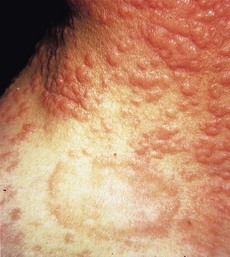198 Mycosis fungoides (cutaneous T-cell lymphoma)
Advanced-level questions
How would you treat this patient?
Treatment is palliative with steroids, chemotherapeutic agents and electron-beam therapy.
What are the stages of cutaneous T-cell lymphoma?
• Stage I: eczematoid or psoriasiform erythematous lesions
• Stage II: infiltrated plaques
• Stage III: nodules (Fig. 198.2), ulcers, tumours
• Stage IV: lymph node involvement with or without systemic dissemination.
Prognosis is good for early mycosis fungoides (Arch Dermatol 1996;132:1309–13).
What is the treatment of mycosis fungoides?
• Various superficial treatments: topical steroids and chemotherapeutic agents (mechlorethamine and carmustine), psoralen plus ultraviolet A (PUVA) and electron-beam radiotherapy improve skin disease, but none has been shown to alter the natural history of the disease.
• Novel approaches being explored include aciclovir, interferons, retinoids, pentostatin, monoclonal antibodies directed to T-cell antigens, extracorporeal photopheresis and interferon-alfa (Lancet 1997;350:32–3).








